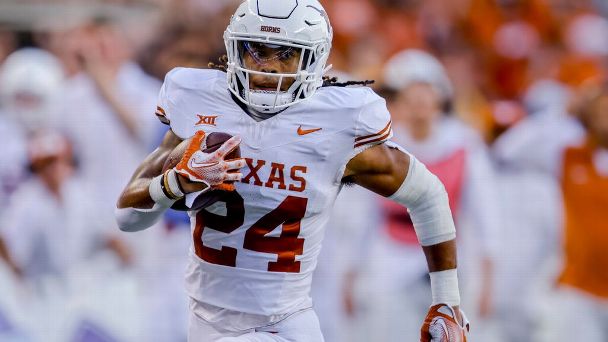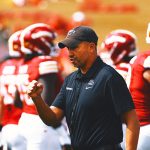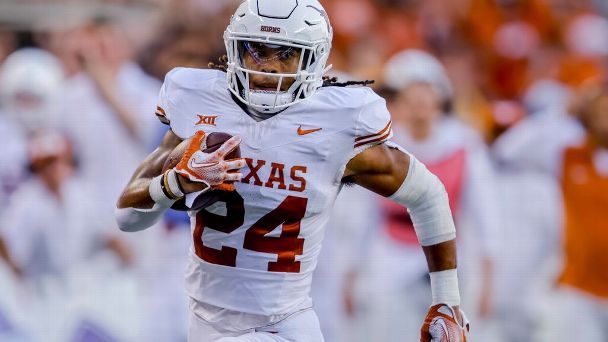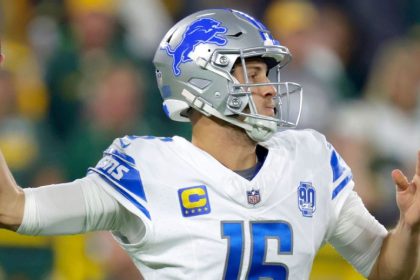
WE ALL KNOW plenty about the game known as the Red River Rivalry. And we should.
There might not be another college football contest that does a better job of wrapping its gloves around everything we love about the sport than when Texas and Oklahoma square off on the second weekend of October. On Saturday, they will meet at high noon on ABC, a top-12 matchup with a Big 12 inside lane on the line.
You want tradition? How about Bevo’s 1,800-pound self, sauntering onto the sideline to watch the 1,020-pound Sooner Schooner wagon come barreling into the Cotton Bowl, pulled by land-grabbing ponies and covered in RUF/NEKS.
You want history? How about a game that Saturday will be played for the 119th time, a series that started seven years before the Oklahoma Territory achieved statehood. It has been played for 94 consecutive years, dating back to Oct. 19, 1929. Since 1948, it has sold out 75 times, including this year.
You want competition? How about a series that is led by Texas 63-50-5 but since the end of World War II has been split nearly precisely down the middle with 39 wins for the Sooners, 37 wins for the Longhorns and three ties. In fact, what is considered perhaps the most epic game in Red River rivalry history was one of those ties. The 6-6 stalemate of 1976 ignited wild conspiracy claims of spying. It was fitting, considering President Gerald Ford, he of the Warren Commission and the pardoning of Richard Nixon, was in attendance.
You want symmetry? How about all of that you just read, plus a game location of Dallas because Big D was seen as the perfect Red River DMZ, located almost exactly halfway between the two campuses in Austin, Texas, and Norman, Oklahoma. And then there is that seating configuration. The Cotton Bowl is split exactly down the middle, the 50-yard line acting as a Bowie knife, evenly dividing the 92,100-seat oval into equal halves of UT burnt orange and OU crimson and cream. That leaves entire sections of hundreds of fans sitting with their shoulders mashed and colors clashed for four hours in the Texas heat. As former Horns head coach Mack Brown once explained: “It’s not like your home crowd or your away crowd, where it’s loud for you and quiet for the opponent. In this game, somebody is screaming every play.”
0:24
Rattler’s bizarre fumble sets up Ehlinger’s TD
Spencer Rattler loses the football right into the hands of Texas linebacker Juwan Mitchell. Sam Ehlinger would score for the Longhorns on the ensuing drive.
You want a heart-stopper? Just go back and watch the highlights of this game over the past decade alone. From 2014 through 2021, the largest margin of victory was eight points and the average score over eight contests was Oklahoma 36, Texas 32. Heck, just watch that eight-point game. The 2020 contest was an anti-’76 affair that stretched into four overtimes and was played for nearly five hours before former Sooners QB Spencer Rattler — who had been benched earlier in the game for fumbling — threw a TD pass to Drake Stoops, son of former Sooners head coach Bob Stoops, to win the game 53-45. Or, if you want to take that question literally, you could step outside the stadium gates and directly into the State Fair of Texas, the event that envelopes the Cotton Bowl and this game, and choke down a basket of deep-fried cheesy crab tater bites or a plate of deep-fried honey butter brisket swirls. My Crestor bottle started vibrating just by me typing that.
From Darrell Royal and Bud Wilkinson to Billy Sims and Earl Campbell to Ricky Williams and Baker Mayfield and, yes, this weekend with Quinn Ewers versus Dillon Gabriel in a battle of undefeated College Football Playoff hopefuls, every single time these two teams have met, the stakes — and steaks — have been scorching hot.
But this year, the official framing of the game comes with some sadness. As if a famous western wear store was suddenly closing shop. The end of an era. Texas and Oklahoma’s last cleated steps in a long march together as members and co-anchors of the Big 12 Conference.
ONE YEAR FROM now, this game will be played again, just as it has been every autumn since the turn of the previous century. Only from 2024 and beyond, it will be an SEC matchup. Ever since July 21, 2021, when the news broke of the schools’ joint decision to break ranks with the Big 12 and reach out to the SEC, collegiate athletics has been a never-ending Jenga puzzle, pieces pulled from conferences coast-to-coast and then jammed back into any available opening in any and every manner necessary to keep the entire tower from crumbling down. So many of those moves don’t make sense. What they generate in cash they seem to equally lose when it comes to the valuation of regional relevance and tradition.
The banks of the Red River are certainly a long way from The Swamp of Florida or the Congaree River that flows by South Carolina’s Williams-Brice Stadium on its way down to Charleston. But the two states whose shared border is drawn along that Red River also snap nicely into the left side of the continuous jigsaw map that represents the footprint of the Southeastern Conference. There are no gaps, from the Atlantic Coast and Gulf of Mexico all the way into the Great Plains as they roll up into central Oklahoma.
However, much more crucial than cartography is the calendar. The Red River rivalry’s streak of games played will not be stopped, unlike so many other rivalries that have at worst been completely sunk or at least been put on extended hiatus by the cold spreadsheets and shredded maps of realignment (*clears throat* ahem, Texas-Texas A&M).
This is not the first time this game has undergone an extreme matchup makeover. Yes, it has served as the centerpiece event of the Big 12, but only since 1996, when the conference was formed out of necessity during the first real lineup shakeup of college football’s modern age. Prior to that, Oklahoma-Texas was not an in-conference matchup.
From 1920 through ’95, the Sooners were not a member of the Southwest Conference, a fact that would no doubt stump any younger-generation football fans at their local sports bar’s trivia night. They were in the Big Eight, which had been the Big Seven, the Big Six and, in the beginning, the Missouri Valley Intercollegiate Athletic Association.
Texas was a founding member of the Southwest Conference in 1915 and remained there until it collapsed in 1995 to give way to the Big 12. OU was also an OG Southwest member but left at the end of the 1919 season.
So, if you’re scoring at home, and plenty of Sooners and Horns certainly are, then through Saturday, over 119 games played, the Red River game has been a conference showdown 33 times, five in the Southwest and 28 in the Big 12. That’s only 28% of the games. The other editions of the game have been everything from a clash of independents to Southwest vs. Big 8 to SWC vs. MVIAA.
IN OTHER WORDS, when one backs up and looks at the bigger picture, whether it be in black-and-white silver emulsion or gigapixel high resolution, the concept of OU and UT in the SEC doesn’t seem all that strange, certainly when compared to the other incongruous college sports chess moves that will be taking place at the same time as theirs next fall.
The difference? This game — in the minds of so many, the game — isn’t going anywhere.
“I don’t need but maybe one or two of things in my life to still be there all the time so that I know it is still my life,” explained Barry Switzer, who coached in 22 Red River rivalry games, six as an Oklahoma assistant and 16 as head coach. His comments came in late summer 2021, not long after the news of the move to the SEC had broken.
“As long as that game is on that weekend in that place, I suppose I can make the rest of it work.”











